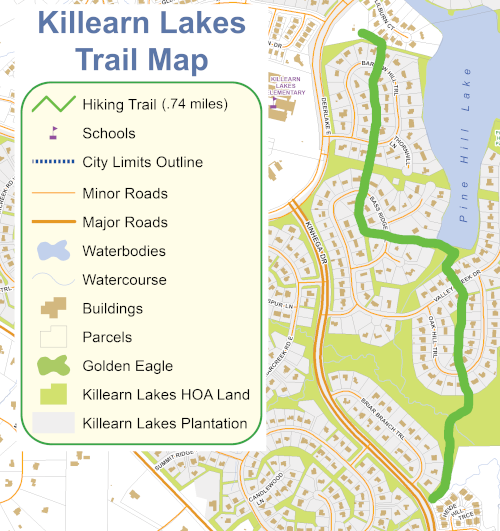Killearn Lakes is a wonderful place to live and raise a family. We are blessed with a natural setting which many equate to a State Park. We have three community parks and six lakes among our many amenities which add to the value of our living experience. The six lakes have docks and boat landings. Killearn Lakes is now a community composed of almost 3,000 acres with 4,225 property owners.
Learn more about our many amenities below:
| Killearn Lakes has six lakes throughout the neighborhood. These were manmade in the 1950's by spring feeding. Five are maintained by the HOA (hyperlinks are to lakes Google Maps locations): - Dianne Lake (135 acres, maintained by Golden Eagle HOA) - Lake Arrowhead (8 acres, fishing dock) - Lake Blue Heron (58 acres) - Lake Monkey Business (39 acres, fishing dock/boat ramp) - gated access, purchase a key from the HOA Office for $20. - Petty Gulf Lake (25 acres, boat ramp) - Pine Hill Lake (34 acres, fishing dock/boat ramp) - gated access, purchase a key from the HOA Office for $20. Lakes Reports: "Marshall, a Killearn Lakes resident, catching and releasing a Largemouth Bass at Lake Monkey Business." All of the lakes are interconnected below Lake Arrowhead. We ask that you catch and release any fish caught in the lakes. In order to keep the growth of invasive aquatic plants under control, maintenance of the lakes consist of spraying herbicide treatments and adding Sterile Triploid Grass Carp. Here's a link to additional UF Plant management: https://plants.ifas.ufl.edu/manage/ Invasives that currently exist: Hydrilla, Water Hyacinths, Duckweed, Alligator-weed, Tara. Lake Blue Heron has Filamentous Algae and Lyngbya. Of the five Lakes maintained by the HOA, Lake Blue Heron is currently experiencing the worst invasive plant intrusion. Per Naturalake Biosciences, "There are few things as difficult to treat as Lyngbya." The main sources of filamentous algae in the lake come from: 1) Air 2) Septic Systems 3) Roads debris. The continued explosion of residential and commercial developments throughout Killearn Lakes has provided significant excess stormwater runoff entering our lakes mostly untreated. As a result, aquatic plant expansion in any lake could occur within a year or less without continued management. |
Click the images below to learn more about the fish species found in our lakes (including how to catch them): |
|---|
Fish Illustrations by Duane Raver and USFWS National Digital Library.
Killearn Lakes has three parks throughout the neighborhood (hyperlinks are to parks Google Maps location):
 Lake Monkey Business Park - Fishing, picnic tables, water access, and docks. Gated access, purchase a key from the HOA Office for $20.
Lake Monkey Business Park - Fishing, picnic tables, water access, and docks. Gated access, purchase a key from the HOA Office for $20. As residents of Killearn Lakes, we all own this beautiful well marked trail from Kinhega (between Hollis and Briar Branch) to Pine Hill Lake dam and to Valley Creek. At different times of the year residents can enjoy beautiful Red Maples, Pink Native Wild Azalea blooms, Sparkleberries cover the trail with bell shaped flowers and a clear creek runs through it all. Remnant old giant long leaf pines, short leaf and loblolly pines refresh the air.
As residents of Killearn Lakes, we all own this beautiful well marked trail from Kinhega (between Hollis and Briar Branch) to Pine Hill Lake dam and to Valley Creek. At different times of the year residents can enjoy beautiful Red Maples, Pink Native Wild Azalea blooms, Sparkleberries cover the trail with bell shaped flowers and a clear creek runs through it all. Remnant old giant long leaf pines, short leaf and loblolly pines refresh the air.
Additional plants along the trails: Dewberry, Yellow Carolina Jessamine vines, Virginia Creeper, Trillium plants, Florida Anise, Red Partridge Berry, Pea Plants, Pink Azaleas, Blueberry, Wood fern, and Red Berried Yaupon Holly. Trees along the trails: Red Maple, Cedar, some giant Short Leaf Pine, Long Leaf Pine, Loblolly Pines, Oak, great smelling Bay trees, White Flowering Dogwoods, and a tunnel of Sparkleberry trees.
Invasives along the trails: Coral Ardisia, Popcorn trees, Potato vines, Japanese Climbing vine, and Nandina.


